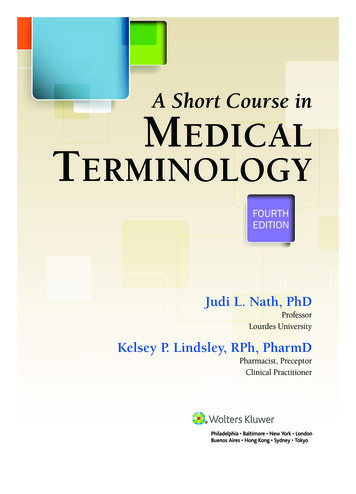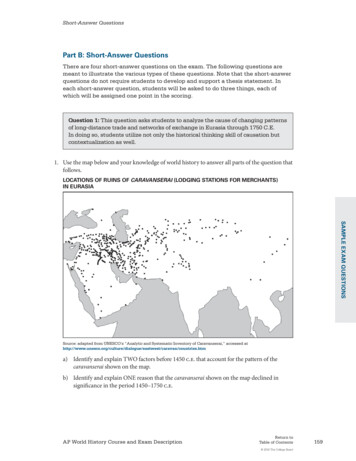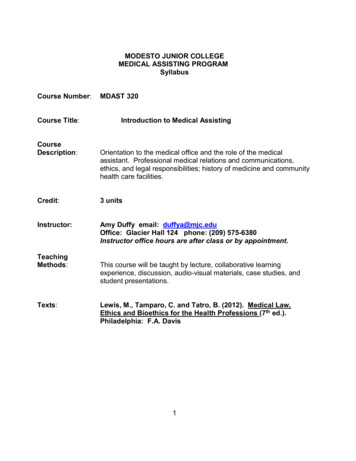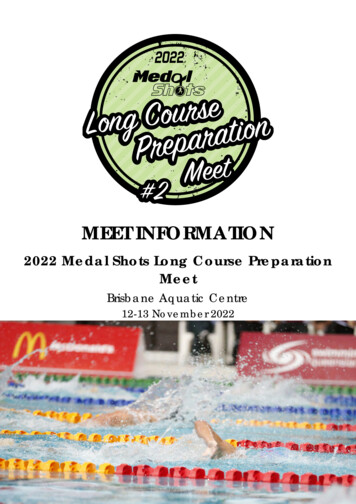
Transcription
A Short Course inMedicalTerminologyFOURTHEDITIONJudi L. Nath, PhDProfessorLourdes UniversityKelsey P. Lindsley, RPh, PharmDPharmacist, PreceptorClinical PractitionerNath9781496351470-fm.indd 126/10/17 3:55 PM
Acquisitions Editor: Jonathan JoyceDevelopment Editor: Amy MillholenEditorial Coordinator: John LarkinEditorial Assistant: Tish RogersMarketing Manager: Leah ThomsonProduction Project Manager: David SaltzbergDesign Coordinator: Holly Reid McLaughlinManufacturing Coordinator: Margie OrzechPrepress Vendor: S4Carlisle Publishing ServicesFourth editionCopyright 2019 Wolters Kluwer.Copyright 2012, 2009, 2003 Wolters Kluwer Health/Lippincott Williams & Wilkins. All rights reserved. This book isprotected by copyright. No part of this book may be reproduced or transmitted in any form or by any means, including asphotocopies or scanned-in or other electronic copies, or utilized by any information storage and retrieval system withoutwritten permission from the copyright owner, except for brief quotations embodied in critical articles and reviews. Materialsappearing in this book prepared by individuals as part of their official duties as U.S. government employees are not covered bythe above-mentioned copyright. To request permission, please contact Wolters Kluwer at Two Commerce Square, 2001 MarketStreet, Philadelphia, PA 19103, via email at permissions@lww.com, or via our website at lww.com (products and services).9 8 7 6 5 4 3 2 1Printed in ChinaLibrary of Congress Cataloging-in-Publication DataNames: Nath, Judi Lindsley, author.Title: A short course in medical terminology / Judi L. Nath, Ph.D., LourdesUniversity, Kelsey P. Lindsley, R.Ph., Pharm.D.Description: Fourth edition. Philadelphia: Wolters Kluwer Health, [2019] Revision of: Short course in medical terminology / C. Edward Collins, Textand Academic Authors Association, St. Petersburg, Florida. Includesindex.Identifiers: LCCN 2017044655 ISBN 9781496351470 (paperback)Subjects: LCSH: Medicine—Terminology. Medical sciences—Terminology. BISAC: MEDICAL / Dictionaries & Terminology.Classification: LCC R123 .C594 2019 DDC 610.1/4—dc23 LC record available at https://lccn.loc.gov/2017044655This work is provided “as is,” and the publisher disclaims any and all warranties, express or implied, including any warrantiesas to accuracy, comprehensiveness, or currency of the content of this work.This work is no substitute for individual patient assessment based upon healthcare professionals’ examination of each patientand consideration of, among other things, age, weight, gender, current or prior medical conditions, medication history,laboratory data, and other factors unique to the patient. The publisher does not provide medical advice or guidance and thiswork is merely a reference tool. Healthcare professionals, and not the publisher, are solely responsible for the use of this workincluding all medical judgments and for any resulting diagnosis and treatments.Given continuous, rapid advances in medical science and health information, independent professional verification ofmedical diagnoses, indications, appropriate pharmaceutical selections and dosages, and treatment options should be made,and healthcare professionals should consult a variety of sources. When prescribing medication, healthcare professionals areadvised to consult the product information sheet (the manufacturer’s package insert) accompanying each drug to verify, amongother things, conditions of use, warnings and side effects and identify any changes in dosage schedule or contraindications,particularly if the medication to be administered is new, infrequently used or has a narrow therapeutic range. To the maximumextent permitted under applicable law, no responsibility is assumed by the publisher for any injury and/or damage to personsor property, as a matter of products liability, negligence law or otherwise, or from any reference to or use by any person ofthis work.LWW.comNath9781496351470-fm.indd 226/10/17 3:55 PM
This book is dedicatedto my students and colleaguesat Lourdes University,who continue to provide inspirationand support. Thank you!-JUDI L. NATHThis book is dedicated to my parents,who have always loved and supported meand who accepted dishwashingin exchange for rentwhile I was working on this book.-KELSEY P. LINDSLEYNath9781496351470-fm.indd 326/10/17 3:55 PM
New to This EditionThis new edition builds on the foundation established in the previous three editions. The reader willfind the writing style of this edition easy to follow, with special focus given to ensuring that eachpage is user friendly and accessible to all levels of learning. As educators, we wanted to be sure thatstudents found the content manageable, interesting, and understandable.APPROACH AND CONTENT ORGANIZATIONThis section outlines the global changes that were made throughout the entire textbook as well asthe chapter-by-chapter changes. We begin with those changes across the chapters.Global Changes The narrative has been modernized to make the text more user-friendly and approachablefor students. The chapter headings have been standardized to appear in a consistent order so material ispresented utilizing a consistent style. The topics in the study table were also standardized so that the order follows a predictablesequence. Study Tables may contain terms that are not in the narrative; however, all bold-faced termsin the narrative are found in the Study Tables. The book would become unwieldy with textif the terms in the tables were also in the narrative. We have selected the most relevant termsfor inclusion in the tables. The end-of-chapter exercises have been standardized, so that from chapter-to-chapter exercisesare presented in the same order. Chapter 15 The Special Senses of Sight and Hearing has been moved to appear directly afterChapter 7 The Nervous System. This order makes sense from a functional perspective andmatches other current anatomy and physiology books. Rearranging the topics in this manneralso allows the book to be used in tandem with an anatomy and physiology course. All terminology has been updated per current medical usage. Stedman’s Medical Dictionary,Terminologia Anatomica, Terminologia Histologica, Terminologia Embryologica, and leadingmedical journals were used to standardize the medical terms, so that they are current andmatch terms used in common practice. Pronunciations match Stedman’s Medical Dictionary. Although Stedman’s Medical Dictionaryuses a diacritic format whereby signs and symbols are used with letters to indicate pronunciations, the pronunciations given in this book are those used for oral communication so weused phonetic pronunciations. Appendixes A through E have been updated so the information is the most current, nationally recognized. The artwork has been updated and revised extensively to be accurate and contemporary. Wealso improved the text–art integration to enhance the student learning experience.ivNath9781496351470-fm.indd 426/10/17 3:55 PM
New to This Editionv Citations from image captions have been removed, so that the reader is not distracted fromthe image and its learning opportunity. Unnecessarily long table titles were shortened to make table titles easier for students to readand understand. More photos were added for realism and interest. The phrase “word elements” was changed to “word parts” to avoid ambiguities when someword parts served double functions, as in sometimes a word part was a root and a prefix. Thischange also enabled consistency. Quick Checks were updated to provide benchmarks within the chapter for students to assessretention of information. Sidebar Information was updated with interesting facts. It is also designed so that it is a “pointable feature” and there is at least one per chapter. Material from Crossword Puzzles and Chapter Quizzes has been folded into the End-of-ChapterExercises.Revised Table of ContentsChapter 1Chapter 2Chapter 3Chapter 4Chapter 5Chapter 6Chapter 7Chapter 8Chapter 9Chapter 10Chapter 11Chapter 12Chapter 13Chapter 14Chapter 15Analyzing Medical TermsCommon Prefixes and SuffixesOrganization of the BodyThe Integumentary SystemThe Skeletal SystemThe Muscular SystemThe Nervous SystemThe Special Sense of Sight and HearingThe Endocrine SystemThe Cardiovascular SystemThe Lymphatic System and ImmunityThe Respiratory SystemThe Digestive SystemThe Urinary SystemThe Reproductive SystemBasic Chapter Outline Template1.2.3.4.5.6.7.8.9.10.11.Learning Outcomes (changed from learning objectives)IntroductionWord Parts Related to the XXX SystemStructure and FunctionQuick Check (at lease one per chapter)Disorders Related to the XXX SystemDiagnostic Tests, Treatments, and Surgical ProceduresPractice and PractitionersThe XXX System Abbreviation TableSidebar (at least one per chapter)The XXX System Study Table (alphabetized within subheadings) Structure and Function Disorders Diagnostic Tests, Treatments, and Surgical Procedures Practice and Practitioners12. End-of-Chapter Exercises—not all exercises may be present, but the order of exercises is maintained Exercise X-X Labeling Exercise X-X Word PartsNath9781496351470-fm.indd 526/10/17 3:55 PM
viNew to This Edition Exercise X-X Word BuildingExercise X-X MatchingExercise X-X Multiple ChoiceExercise X-X Fill in the BlankExercise X-X AbbreviationsExercise X-X SpellingExercise X-X Case StudyChapter-by-Chapter ChangesChapter 1 Analyzing Medical Terms New Art: Figure 1-1New Word Parts: nonNew Terms: etymology and language senseDeleted Word Part: clericAdded new Quick CheckChapter 2 Common Prefixes and Suffixes Changed chapter title from Common Suffixes and Prefixes to Common Prefixes and Suffixesand changed the order of presentation in the chapter so that prefixes are introduced beforesuffixes and to match the new chapter title New Word Parts: a-, an-, anti-, -cele, -cyte, de-, dis-, -eal, -edema, -emesis, -emia, -ism, -lith, -lysis,-oid, -opsy, -pathy, -phobia, -plasia, -poesis, -rrhea, -sclerosis, -stasis, -stenosis, -stomy, tic, and –tome Added new Quick CheckChapter 3 Organization of the Body Changed chapter title from The Body’s Organization to Organization of the BodyNew Art: Figures 3-1, 3-2, 3-3, 3-4, 3-5, 3-6, and 3-7New Word Parts: gastr/o and thorac/oNew Terms: abdominal cavity, anatomy, caudal, cephalad, cervix, coccyx, coronal plane, cranial, lumbus, pelvic cavity, physiology, sacrum, thorax, and ventral Deleted Terms: anatomical terms of location, dorsal cavity, and midsagittal Added new Quick CheckChapter 4 The Integumentary System New Art: Figures 4-1, 4-6, and 4-10 New Word Parts: adipo- and -oma New Terms: arrector pili muscles, benign, bulla, carcinoma, decubitus ulcers, edema, erythematous, fissure, hypodermis, integumentary system, malignant, plaque, pruritic, prurigo, and whealChapter 5 The Skeletal System New Art: Figures 5-1, 5-2, 5-8, 5-9, 5-10, 5-11, 5-12, 5-13, 5-14, and new images for Table 5-3 New Terms: appendicular skeleton, axial skeleton, carpal bones, closed fracture, compoundfracture, compact bone, cranial suture, cranium, epiphyseal plate, hip bone, joint, kinesiologists,lateral malleolus, ligaments, tendons, medial malleolus, neoplasms, occupational therapists,open fracture, osseous tissue, physical therapists, simple fracture, spongy bone, sternum,synovial fluid, synovial joint, tarsal bones, thoracic cage, and vertebral column New Abbreviations: MRI and NSAID Deleted Abbreviations: CTS and LE Deleted Terms: chondrodynia and dactylomegaly Deleted Word Parts: cheir/o and -desisNath9781496351470-fm.indd 626/10/17 3:55 PM
New to This EditionviiChapter 6 The Muscular System Deleted Table 6-2 because it is in Chapter 5Reorganized comparative art in Figure 6-1Added new Sidebar on dysphagia and dysphasiaNew Art: Figures 6-2 and 6-5New Abbreviations: ALS, FX, MD, NSAID, and PTDeleted Abbreviations: CTD, DMD, and DTRNew Terms: agonist, Duchenne dystrophy, dysphagia, fascicle, muscle fibers, paresis, skeletalmuscle, and striated muscle Deleted Terms: myoparesis, tenalgia, tenontoplasty, tendoplasty, and tenoplastyChapter 7 The Nervous System New Art: Figures 7-1, 7-3, 7-5, 7-6, 7-8, and Labeling Exercise 7-1New Abbreviations: AD, CSF, CT, DM, MRI, and PDDeleted Abbreviations: IQ, OBS, PERRLA, SAD, and TENSNew Terms: demyelination, lesion, seizure, sympathetic nervous system, and parasympatheticnervous system Term Changes: changed brain stem to brainstem per Terminologia Anatomica, changed petitmal seizure to absence seizure Added a new sidebar on the difference between psychiatrist and psychologist Deleted Terms: subsystemsChapter 8 The Special Senses of Sight and Hearing New Art: Figures 8-2, 8-3, 8-4, 8-8, 8-9, and Labeling Exercise 8-1New Abbreviations: EOM, LASIK, and O.D.Deleted Abbreviations: ASL, dB, ECCE, ERG, ICCE, and PVDNew Terms: auditory tube, cones, external acoustic meatus, deaf, extra-ocular muscles,eyebrows, eyelashes, eyelids, lacrimal ducts, lacrimal fluid, lacrimal glands, lacrimal sac,laser-assisted in situ keratomileusis (LASIK), lateral angle of eye, medial angle of eye, orbit,refraction, rods, and scleral buckle Term Changes: inner canthus changed to medial angle of the eye, outer canthus changed tolateral angle of the eye, outer ear changed to external ear, inner ear changed to internal ear,external auditory canal changed to external acoustic meatus, and eustachian tube changedto auditory tube per Terminologia Anatomica Deleted Word Parts: dacryocyst/o, irit/o, and phak/oChapter 9 The Endocrine System New Art: Figure 9-1, 9-3, 9-4, 9-5, 9-6, 9-7, and Labeling Exercise 9-1New Abbreviations: T3, T4, CT, PTH, and GTTDeleted Abbreviations: BS, IDDM, and NIDDMNew Terms: corticosteroids, fasting blood sugar (FBS), goiter, exophthalmos, hypothalamus,pineal gland, glands, polydipsia, polyuria, and thyroid-stimulating hormone (TSH)Chapter 10 The Cardiovascular System New Art: Figures 10-5, 10-6, and 10-7 Deleted Abbreviations: CP, ICU, Rh , and Rh– New Terms: apex, atrioventricular valves, coronary artery disease, embolus, heartbeat, pulmonary circuit, and systemic circuit Deleted Terms: arteritis, cardiodynia, cardiomalacia, pericardial sac, and phagocyteNath9781496351470-fm.indd 726/10/17 3:55 PM
viiiNew to This EditionChapter 11 The Lymphatic System and Immunity New Art: Figures 11-1, 11-2, 11-3, 11-4, and Labeling Exercise 11-1New Abbreviations: EBVDeleted Abbreviations: CBC, HLA, and RIADeleted Figure: former Figure 10-1New Terms: allergy, autoimmune disease, elephantiasis, immunization, lymph node, lymphography, pathogen, systemic lupus erythematosus, vaccination, and vaccineChapter 12 The Respiratory System Changed The Nose heading to The Nose, Nasal Cavity, and Paranasal Sinuses; changed ThePharynx heading to The Pharynx and Tonsils; added new section on The Diaphragm Added new Sidebar on the common cold viruses New Word Part: adeno New Art: Figures 12-1, 12-3, 12-4, 12-6, 12-7, 12-8, 12-9, and Labeling Exercise 12-1 New Abbreviations: BP, c/o, F, ICU, P, T and A, URI, VC, and WBC Deleted Abbreviations: T&A changed to T and A Deleted Figure: former Figure 11-4 New Table 12-2 Pulmonary Volumes and Capacities New Terms: cyanosis, lungs, nasal cavity, nasal septum, nose, paranasal sinuses, tonsils, andventilationChapter 13 The Digestive System New Art: Figures 13-1, 13-2, 13-3, 13-5, and Labeling Exercise 13-1Changed common bile duct to bile duct per Terminologia AnatomicaNew Abbreviations: NG and UGISDeleted Abbreviations: GB, GBS NGT, and UGINew Terms: absorption, bile duct, digestion, elimination, esophagogastroduodenoscopy, irritable bowel syndrome, and lower esophageal sphincter Deleted Terms: common bile duct and fundusChapter 14 The Urinary System New Art: Figures 14-1, 14-3, and Labeling Exercise 14-1Changed perirenal fat to perinephric fat or pararenal fat body per Terminologia AnatomicaAdded information on the nephron, glomerulus, and glomerular filtration rateNew Abbreviations: ARF and CRFDeleted Abbreviations: BPH and PSANew Terms: antibiotic, calyx, kidney transplant, micturition, nephropexy, renal corpuscle,renal cortex, renal medulla, renal pelvis, and renal tubuleChapter 15 The Reproductive System New Art: Figures 15-1, 15-4, 15-6, 15-7, and Labeling Exercise 15-1New Sidebar on meiosis and mitosisChanged amniotic sac to amnion per Terminologia AnatomicaChanged spermatozoon and spermatozoa to sperm per Terminologia HistologicaNew Abbreviations: A, C-section, EDC, EDD, G, HIV, P, Pap smear, STD, and STIDeleted Abbreviations: DUF, HRT, HSG, IUD, PMS, TAH, and VDNew Terms: abortus, amnion, amniotic fluid, amniotic sac, clitoris, glans, foreskin, fundus,labium majus, labium minus, umbilical cord, urologist, and vulvaNath9781496351470-fm.indd 826/10/17 3:55 PM
New to This EditionixOTHER RESOURCESOnline ancillary materials complement the text and provide additional support for student learning.Student Resources: Question Bank, with a variety of exercise types to reinforce chapter materialEducational Games, such as crossword puzzles, hangman, and word-building challengesAudio GlossaryFlash Cards, including Flash Card GeneratorChapter QuizzesFinal ExamInstructor Resources: PowerPoint slides and Lesson Plans include useful information to facilitate presentation ofmaterial by instructors. Test Generator, with more than 500 questions to test students’ knowledge of terms, theirmeanings, and abbreviations. Handouts include additional puzzles and games for additional student practice.Nath9781496351470-fm.indd 926/10/17 3:55 PM
Author’s PrefaceWelcome to the field of medical terminology. This workbook-textbook is written to teach the language of medicine in an engaging and meaningful way. It is written to represent the real world so thatyou can move seamlessly from the classroom to actual practice. The approach is based on researchthat demonstrates how students learn best. To that end, we used a three-pronged approach: (1) immersion—the terms are presented in context; (2) chunking—the material is given in manageableunits; and (3) practice—exercises that allow you to check your knowledge. Learning word parts isalso an essential component of learning the terms. If you learn the tables of word parts, you will bewell on your way to knowing medical terms you have never encountered, because you can figureout the terms by breaking them into their component word parts. This will be quite useful, becausenot every word you will encounter in your careers is found in this book, but you will be equippedwith the knowledge to understand their meaning. We also encourage you to pay special attentionto the analysis sections in the Study Tables, as these provide interesting, foundational informationfor forming medical terms.While learning medical terminology, you will also learn some basic anatomy (body structures),physiology (body functions), and pathology (body diseases). Because medical terms describe thehuman body in health and in disease, attaining an elementary understanding of these topics willhelp you retain a working memory of medical language.Learning medical terms can be easy if you approach the subject from a proper perspective.Begin by telling yourself that medical terms do not make up a separate language. Medical terms aresimply words that you can add to your vocabulary. As with all words, medical words are meant toconvey information.As you enter a medical profession, you will be communicating with other medical professionalsand with patients. Therefore, your job will include choosing words and sentence structures that convey accurate information and reflect a professional attitude. That is to say, both your communicationskills and your attitude toward patients are very important. As you are about to discover, learningmedical terminology can be easy at times and challenging at others. However, if you use the textbookand its ancillaries to their fullest, you will be well on your way to mastering medical terminology.Judi L. Nath, Ph.D.ProfessorLourdes UniversitySylvania, OhioKelsey P. Lindsley, R.Ph., Pharm.D.Pharmacist, PreceptorClinical PractitionerPort Clinton, OhioxNath9781496351470-fm.indd 1026/10/17 3:55 PM
User’s GuideA Short Course in Medical Terminology, Fourth Edition, was developed to provide an easy, efficient,and effective way to learn medical terminology. This User’s Guide introduces the features of the bookthat help the learning experience.A logical organization guides students through the basics of medical terminology, word parts,and word analysis.Chapters 1 and 2 introduce the basics ofword building and set the foundation forlearning terms.Analyzing MedicalTerms1LEARNING OUTCOMESUpon completion of this chapter, you should be able to: Discuss the purpose of medical terminology. Recognize each of the four word parts of medical terms:prefixes, roots, suffixes, and combining forms. Define the commonly used prefixes, roots, and suffixesintroduced in this chapter. Divide medical terms into word parts. Understand how word parts are put together to makemedical terms. Recognize the importance of proper spelling,Common Prefixesand Suffixespronunciation, and use of medical terms.2INTRODUCTIONThere are many ways and various books to help you learn medical terminology. This book is intendedfor a short course in medical terminology and focuses on medical terms, their definitions, and briefexercises to help you quickly gauge your understanding. That means this book can be workedthrough in as little as 8 weeks. Our goal is to give you all the basics you will need to be successfulin your career, while allowing you to have a little fun learning. Every word in the medical field isnot found in this book, but all the Latin and Greek word parts are found here. These word parts canbe combined to make thousands of medical terms, and understanding the basic word parts is thefirst step toward understanding complete words. While it is possible to memorize the definitionsof individual medical words, understanding just the parts that make up the medical word is easierand faster than learning every word because there are fewer word parts than complete words. Infact, approached the right way, medical terminology may be the easiest subject in your program.Learning it takes a bit of thought and an open mind; but it need not involve sweating or rippingout your hair in frustration.Why is medical terminology important? Can’t medical professionals just use simple words like“gut” and “cut”? Unfortunately, these aren’t always specific enough. Gut can refer to the stomach,small intestine, large intestine, or any part of your digestive system. If you have pain in one of theseareas, you would want to be able to easily identify a single area and have all medical professionalsrecognize that specific area. The term “cut” could mean just an incision, or in other cases it couldmean cutting off a body part. For example, “She cut her hand” indicates an incision, but “Cut thehand distal to the wrist” could mean an amputation. Luckily medical terminology allows us tospecifically identify places in the body and even what type of cut it is with words (see Figure 1-1).1Chapters 3–15 offer an overview of each bodysystem and introduce terms that identify thestructure and function of that system alongwith terms that name system disorders, diagnostic tests, treatments, surgical procedures,practice, and practitioners.Nath9781496351470-ch001.indd 1Upon completion of this chapter, you should be able to: Recognize prefixes. Recognize suffixes. Define all of the prefixes and suffixes presented in thischapter. Analyze and define new terms introduced in this chapter. Pronounce, define, and spell each term introduced in thischapter.INTRODUCTIONChapter 1 presented the four word parts used in medical terminology: prefixes, roots, suffixes, andcombining forms. This chapter focuses on prefixes and suffixes.In Chapter 1, we learned that a prefix is a word part that comes at the beginning of a word. Notethat the word prefix itself contains a prefix, pre-. The second part of the word prefix is “fix,” whichgives us a perfect definition of prefix: something affixed (attached) to the front of or before (pre-)something else. Most of the prefixes occurring in medical terms are also found in everyday English.Although we have all used many of the prefixes contained in this chapter, we may have done sowithout realizing that they are prefixes. For example, when we are admitted to an anteroom, we maynot stop to think that the prefix ante- means “before,” and that an anteroom is so called because itis a room we enter before entering another room.We also learned in Chapter 1 that a suffix is the part that comes at the end of a word. The wordsuffix comes from the Latin word suffixum, which may be translated as “to fasten to the end of.” Although the suffix is located last in a medical term, it often comes first in its definition. For example,appendicitis means “inflammation (-itis) of the appendix.” Therefore, the suffix, -itis, provides uswith the first word of the defining phrase. The term gastrectomy is another example. It is definedas “removal of the stomach.” The definition begins with the meaning of the suffix, -ectomy, whichmeans “removal of.”17/10/17 12:05 PMWORD ROOTS INTRODUCED IN THIS CHAPTERTable 2-1 lists common word roots with their meanings to get you started on your task of learning hundreds of medical terms. You may wish to memorize the roots given in the table now,because there are just a few. Or if you prefer, just give them a quick glance now and, as you gothrough the chapter, refer back to this table whenever you run across a term with a root you donot recognize.9Nath9781496351470-ch002.indd 9Nath9781496351470-fm.indd 11LEARNING OUTCOMESxi17/10/17 12:06 PM26/10/17 3:55 PM
Common Prefixesand SuffixesxiiUser’s GuideLEARNING OUTCOMES2Upon completion of this chapter, you should be able to: Recognize prefixes. Recognize suffixes. Define all of the prefixes and suffixes presented in thischapter. Analyze and define new terms introduced in this chapter. Pronounce, define, and spell each term introduced in thischapter.TIONTABLE 3-1An introduction and a tabular presentation ofWord PartTABLE 3-1Partsinrelateda specific bodysystemanter/oented the four wordWordparts usedmedicaltoterminology:prefixes,roots, suffixes,Word Part andcerv/oanter/oare presentedms. This chapter focuseson prefixesnext.and suffixes.chondr/oEach chapter opens with a statementof learning outcomes. These aremeasurable educational aims andobjectives that indicate what youshould be able to do after completing the chapter.3 Organization of the Body293 Organization of the Body29WORD PARTS RELATED TO BODY ORGANIZATIONMeaningWORD PARTS RELATED TO BODY ORGANIZATIONcerv/ofront, anteriorMeaningneckfront, anteriorcartilageneckcellcartilagebackcellstomach, abdomenbackgroinstomach, abdomenmusclegroinspinal cordmusclenerve, neuronspinal cordposterior, backnerve, neuronnearposterior, backsuperiornearchest (thorax)superioracrosschest (thorax)303 Organization of the Body4.5. chondr/oanter/o4.5.5.6. anter/omy/o5.6.6.7. my/osuper/o6.7.common word roots with their meanings to get you started on your task of learn7.8. super/ocerv/oof medical terms. You may wish to memorize the roots given in the tablenow,8.9. cerv/oinguin/oare just a few. Or if you prefer, just give them a quickglancenowand,asyougoOrgan(stomach)9. inguin/oapter, refer back to this table whenever you run acrossa term with a rootyou do10.myel/oTissue7.8.8.9.9.10.10. myel/o10.trillions, it’s easy to appreciate the body’s complexity as a functioning whole. Cells work both individually and together. Although cells differ from one another and consist of different components,trillions,it’s easyto commonappreciatethe body’s complexityas a functioning whole. Cells work both indithey do havesomeelements(seeFigure 3-2):viduallytogether. Althoughcellsdiffersubstancesfrom one anotherand consist of different components, A andcell membranethat allowscertainin and outthey doAhavesomecommonelements within(see Figure3-2):nucleusthatdirects activitiesthe cell A cell membrane that allows certain substances in and out A nucleus that directs activities within the cell9CellNath9781496351470-ch003.indd 2917/10/17 12:06 PMNath9781496351470-ch003.indd 29Organ (body)systemOrganization of the Body 3Organizationof the ofBody Organizationthe BodyOTS INTRODUCED IN THIS CHAPTER3cyt/o, -cyte1, we learned that a prefix is a word part that comes at the beginning of a word.chondr/o Notedors/ocyt/o, -cyterefix itself contains a prefix, pre-. The second part of the word prefix is “fix,”gastr/owhichdors/oinguin/ogastr/o (pre-)ct definition of prefix: something affixed (attached) to the front of or beforemy/omyel/oMost of the prefixes occurring in medical terms are also found in everydayinguin/oEnglish.my/oneur/oave all used many of the prefixes contained in this chapter, we may havemyel/odone soposter/oneur/oproxim/ong that they are prefixes. For example, when we are admitted to an anteroom,we mayposter/osuper/oproxim/onk that the prefix ante- means “before,” and that an anteroom is so called becauseitthorac/osuper/otransnter before entering another room.thorac/oacrossrned in Chapter 1 that a suffix is the part that comes at the end of a word. transThe wordWord Parts ExerciseWord Partsoffer youm the Latin word suffixum,whichExercisesmay be translatedasan“toopportufasten to the endof.”AlAfter studying3-1, write the meaning of each of the word parts.WordParts TableExercisefix is located last in anitymedicalterm, itreviewoften comesfirst inpartsits definition.example,to quicklythe wordbefore ForAfterWORDPARTstudyingTable 3-1, write theMEANINGmeaning of each of the word parts.ans “inflammation moving(-itis) of onthetoappendix.”Therefore, the suffix, -itis, p
the above-mentioned copyright. To request permission, please contact Wolters Kluwer at Two Commerce Square, 2001 Market Street, Philadelphia, PA 19103, via email at permissions@lww.com, or via our website at lww.com (products and services). 9 8 7 6 5 4 3 2 1 Printed in China Library of Congress Cataloging-in-Publication Data











